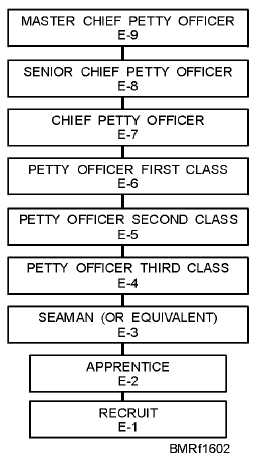Supplemental board members include the—
Division officer,
Division chief, and the
Division career counselor.
ENLISTED CAREER STRUCTURE
Learning Objectives: When you finish this chapter,
you will be able to—
Recognize the paths of advancement and recall
the requirements for advancement of nonrated
personnel.
Identify the eligibility requirements for
advancement to E-2 and E-3 and petty officer.
Recognize selection criteria for advancement
and preparation for advancement.
Identify the career enlistment objectives.
The objective of the enlisted advancement system is
to provide qualified petty officers to operate the Navy’s
ships, squadrons, and shore stations. Advancements, in
turn, provide the opportunity for the orderly progression
of qualified enlisted personnel to higher levels of
r e s p o n s i b i l i t y t h r o u g h o u t t h e i r n ava l c a r e e r.
Information about the advancement system is contained
in BUPERSINST 1430.16. The advancement system
offers you increased pay, prestige, and privileges, as
well as additional responsibilities and authority.
PATH OF ADVANCEMENT
The enlisted advancement structure is organized
into paygrades. E-1 is the lowest enlisted paygrade and
E-9 is the highest. The path of advancement from E-1 to
E-9, along with the title of each paygrade, is shown in
figure 16-2.
The lowest three paygrades (E-1 to E-3) are referred
to as apprenticeships and identified as one of the
following:
Seaman apprenticeship (SR, SA, SN)
Fireman apprenticeship (FR, FA, FN)
Airman apprenticeship (AR, AA, AN)
Constructionman apprenticeship (CR, CA, CN)
Hospitalman apprenticeship (HR, HA, HN)
Dentalman apprenticeship (DR, DA, DN)
Petty officers (E-4 to E-9) and designated strikers
belong to a rating. Ratings are divided into two
categories—general ratings and service ratings.
General Ratings
A general rating is a broad occupational field (a
group of jobs) that requires the same general
qualifications and includes similar duties. Boatswain’s
Mate, Quartermaster, and Storekeeper are all examples
of a general rating. Each rating has its own rating badge.
These rating badges are shown in chapter 10 of this
manual.
In some cases, two or more related general ratings
will combine at the E-8 or E-9 level to form a new
16-3
Student Notes:
Figure 16-2.—Path of advancement.

